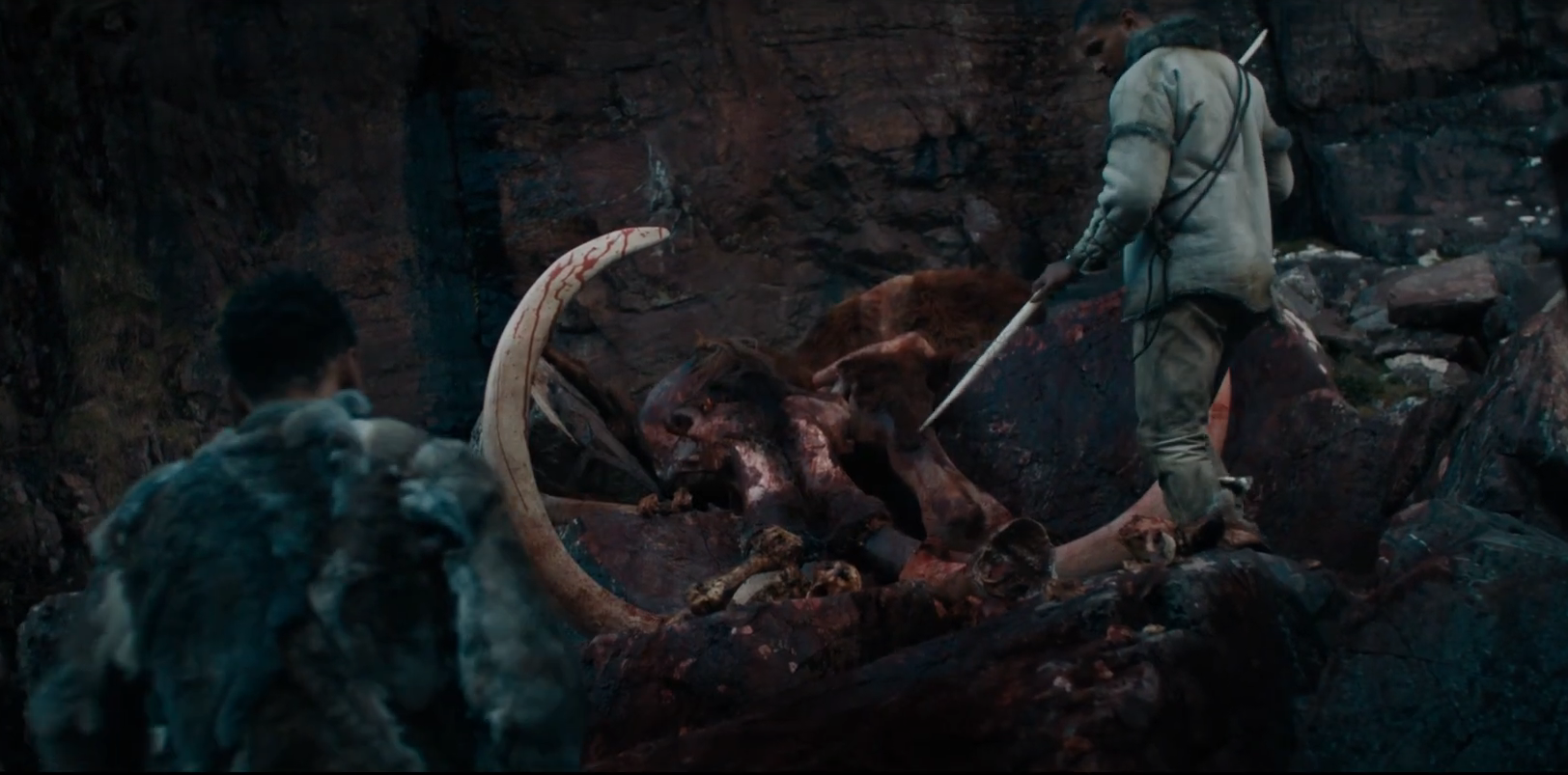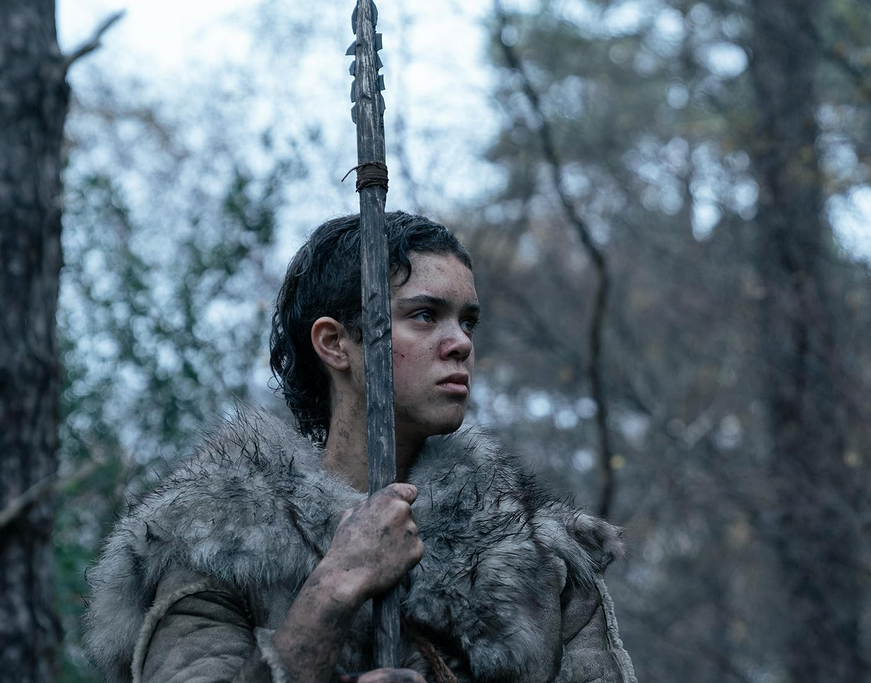Out of Darkness (2022)
Directed By: Andrew Cumming
Written By: Ruth Greenberg, Andrew Cumming, Oliver Kassman
Starring: Safia Oakley-Green, Chuku Modu, Kit Young
Andrew Cumming‘s directorial debut won a long-fought battle to American soil, but is this Stone Age survival fable worth the struggle? Spoilers beyond!
The notion of “Stone Age” movies typically conjures humor, intentional on the part of the filmmakers or otherwise: The Flintstones, Clan of the Cave Bear, Year One, perhaps animated flicks like Early Man and Ice Age. 1981’s French classic Quest for Fire remains the best of a small tribe indeed. Horror’s reach rarely extends past the medieval era; the 2006 Mayan Empire effort Apocalypto, though not a straight-up horror film and set in 1511 CE, is one of few major Hollywood movies to draw on ancient cultures for horrific effect. 2007’s experimental action-horror epic Beowulf, set in 507 CE, might also fit the bill.
Into this overall void arrives Out of Darkness, the debut feature from Andrew Cumming, a British director with television credits and shorts on his resume thus far. Starring newcomer Safia Oakley-Green, Kit Young (Shadow and Bone, The School for Good and Evil), and Chuku Modu (The 100, Game of Thrones), the movie was billed as “paleolithic horror,” but has more academic concerns at heart. With dashes of The Village, Cabin in the Woods, and The Witch, Cumming’s movie is more interested in meta than monsters.
The set-up is simple enough–a beleaguered group forsakes their ancestral land and sails to what they hope will be a fertile new home. Lead by the wink-wink-named Adem (Modu) and his pregnant mate Ave (Iola Evans), they make landfall only to discover–naturally–a countryside devoid of game, comprised of unwelcoming terrain, and stalked by a mysterious threat. This survival-horror conceit gains a fresh spark from the time period depicted; these people are early modern Homo sapiens, and their year is 43,000 BCE. There are plenty of atmospheric visuals to enjoy, including soaring aerial camera work and a few Dutch angles to emphasize just how out of kilter the group’s world has become.
Cumming capitalizes on the necessary lack of diegetic light, playing with campfires and the aurora borealis to heighten a milieu that veers from intimate claustrophobia to staggering agoraphobia. The availability and uses of light are a major in-road to the film’s concerns, calling to mind fire’s place in the human saga and Plato’s allegory of the cave. But it’s the movie’s dialogue which tips off the viewer that we might not be watching a prehistoric monster movie.
After all, who goes to the trouble of inventing a conlang if they don’t feel they’ve really got something to say? Tola, the language spoken by the humans in Out of Darkness, was developed by a linguist who based it on Arabic and Euskara, two of the world’s oldest spoken languages. Despite the language’s fabricated nature, the actors commit, speaking fluently to impressive and emotional effect. As a subtitle devotee, I wasn’t fussed, and I appreciated the director’s interest in developing and maintaining his vision of early humanity.
It’s on that point that viewer reactions to Out of Darkness will likely hinge. Audiences all-in on the notion of “paleolithic horror” might go in envisioning murderous mammoths, slavering smilodons, or other appropriately-Stone Aged monsters… and that audience might be caught off-guard by the film’s twist. Occurring just past the tight 87-minute flick’s mid-point, the monster’s reveal also reveals Cumming’s true goals. Once the “monster” is shown to be a person, almost like our merry band, Out of Darkness stops being survival horror and becomes a first-contact film. Any genre-savvy viewer knows who the villains are in first-contact films. Cumming’s is a canny maneuver, but not one that comes out of the blue. From the first frame, his film displays an interest in meta-narrative, trafficking in our world’s oldest myths and rituals to examine what stories we tell and how narratives are used for gain. Each of the early humans inhabits a role–heir, mate, sage–in the story that drives them.
Most crucially, they’re willing to use the power of story to keep one another in their places.
Any genre-savvy viewer knows how to recognize a Final Girl. Oakley-Green’s character Beyah is an orphan, attached to the group by chance or providence, but her real entry into the movie’s plot machine is loaded with metaphor. Sure does suck to get your period for the first time in the middle of nowhere! Menarche saddles Beyah with roles she doesn’t want, laid out gently by Ave–and less gently by Adem. Adem’s warning that Beyah’s “stray” position means she is available for any other role the group might need feels predatory in the moment.
The viewer and Beyah both recognize that Adem means if his chosen mate dies in childbirth, another childbearing person can step in, whether they want to or not. But Adem also mentions their lack of food in his speech, an omen of the survival cannibalism (with inklings of revenge) occurring later in the story. The group’s seer, Odal, also reiterates Beyah’s un-anchored nature when he attempts to convince the remaining humans to offer Beyah as a sacrifice to the monster hunting them.
In order to interrogate the human impulse to fear–what we’re afraid of, how we perpetuate or defeat fear–Cumming’s film necessarily sets strict metrics. His humans are, to the modern eye and for meta-narrative reasons, heterosexual. His forest is a threat, swallowing Adem’s son Heron (Luna Mwezi) in good fairy-tale fashion. His thesis indicates that humanity has always been subject to abusive patriarchy (Adem leads poorly and dies badly), junk science (Odal thinks menstruation is the same as being in heat), corrupt clergy (Odal makes much of his “wisdom” role but displays none), and misogyny (Ave is thinly characterized, by Adem and the film). This isn’t a particularly fresh vision of ancient humans (though it may act as a rebuttal to various movements lionizing humanity’s pre-modern past).
In many ways Out of Darkness feels like an inverse of The Inheritors, which given its 1955 publication date was a bold manuscript indeed. Yet the film largely succeeds in its enterprise, in no small part due to its willingness to turn its Final Girl into its villain–and then question what lies beyond the villain’s bloody rampage. Beyah shifts from scrappy stray with a Coachella-ready mullet and boots to last woman standing. She takes on the leadership role after literally consuming the predatory and inept Adem. And she finds herself the aggressor when her foe is revealed to be a person much like her: Neanderthals, perhaps the last of their people, are this new land’s inhabitants.
If you’re a die-hard Neanderthal fan like me, you’ll wish Cumming had gone in the direction of archaic admixture (similarly, I thought Alexander Skarsgård should’ve made sweet love to his clone in Infinity Pool). But as a survey of horror tropes, Out of Darkness is naturally concerned with the Other. In order to complete this fable, the monstrous is flipped; a different person embodies the monstrosity. Beyah has become the most frightening thing in the forest. When the Other’s mirror is turned toward her, it shows Beyah’s own face. The hero’s journey has ended, and the villain’s redemption arc is about to begin. If history is written by the victors, horror is drawn along lines of power. Ultimately, Out of Darkness chooses to hope for choices of power beyond violent patriarchy or internalized misogyny.
But this film is set 45,000 years ago. We already know how that story turns out. Perhaps the only question remaining is how many fresh starts humanity has left.





